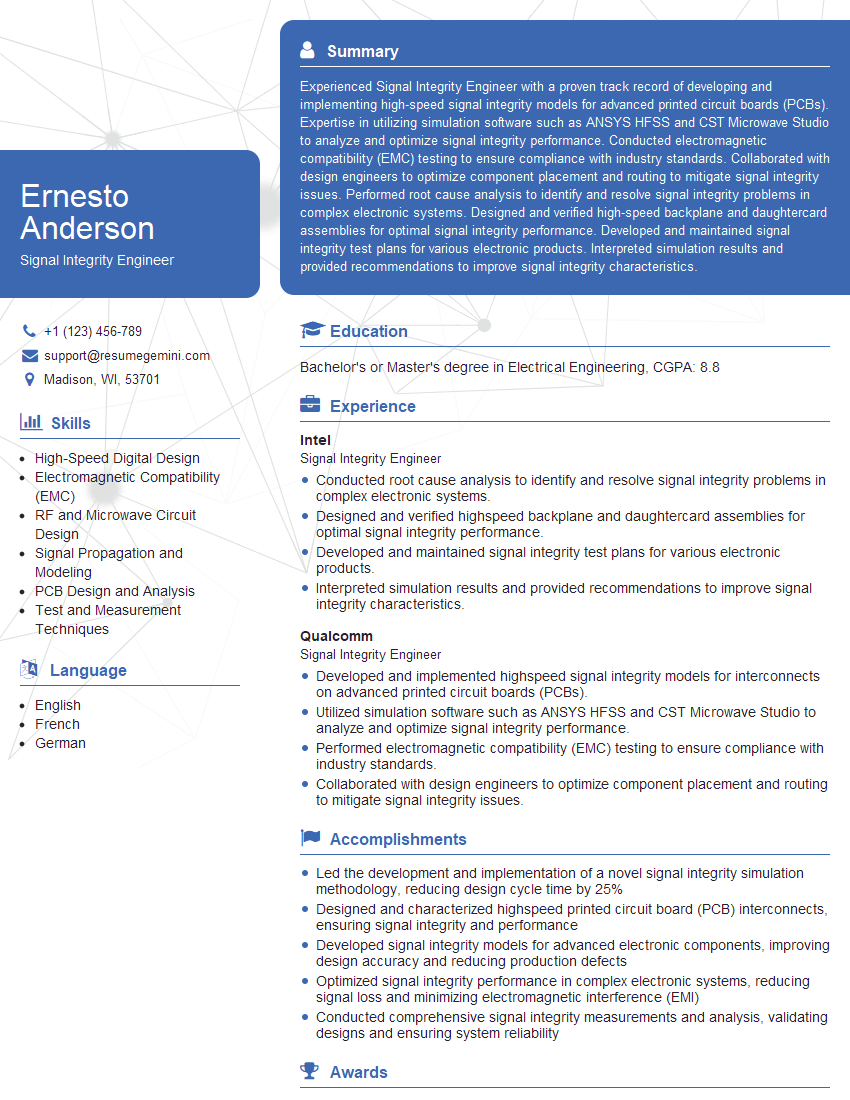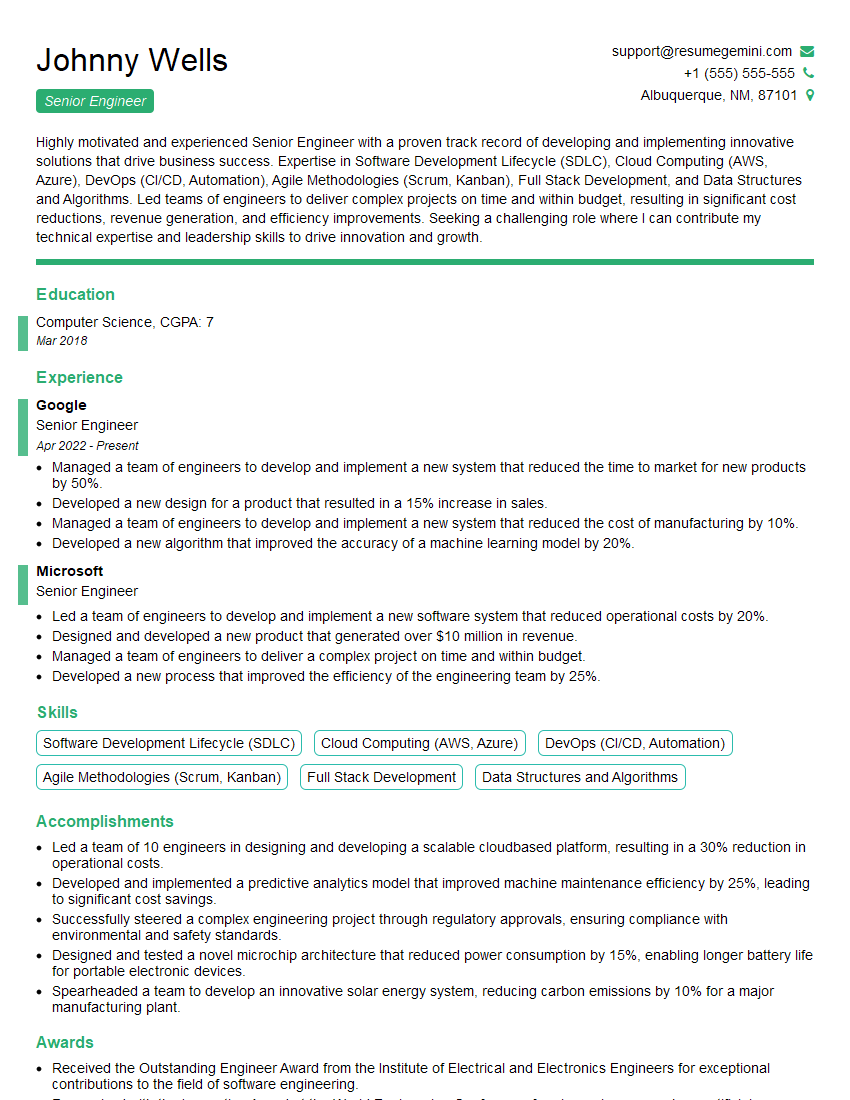Cracking a skill-specific interview, like one for Signal Level Measurement, requires understanding the nuances of the role. In this blog, we present the questions you’re most likely to encounter, along with insights into how to answer them effectively. Let’s ensure you’re ready to make a strong impression.
Questions Asked in Signal Level Measurement Interview
Q 1. Explain the difference between dBm and dBw.
Both dBm and dBw are units used to express power levels, but they differ in their reference points. dBm (decibels relative to one milliwatt) expresses power relative to 1 milliwatt (mW), while dBw (decibels relative to one watt) expresses power relative to 1 watt (W).
Think of it like measuring distance: dBm is like measuring in inches, while dBw is like measuring in feet. Both measure the same thing – distance or power – but use different scales. A 30 dBm signal is equivalent to 1 Watt (30 dBm = 10 log10(1000mW/1mW) = 30 dBm, 0 dBw = 10 log10(1W/1W) = 0 dBw), and a 30 dBw signal is significantly more powerful at 1000 Watts (30 dBw = 1000W).
In practice, dBm is frequently used for lower power signals, common in things like mobile phones and Wi-Fi, while dBw is often used for higher power signals, such as in broadcast transmitters.
Q 2. What are the common units used for signal level measurement?
Signal level measurement uses several common units, primarily focusing on power and voltage. Here are some:
- dBm: Decibels relative to one milliwatt. Most commonly used in RF and microwave applications.
- dBw: Decibels relative to one watt. Used for higher power signals.
- dBuV: Decibels relative to one microvolt. Commonly used in antenna and cable signal measurements.
- dBu: Decibels relative to 0.775 volts. Often seen in audio engineering.
- Volts (V): A direct measure of voltage, useful for many electrical signals.
- Watts (W): A direct measure of power, used in various applications.
The choice of unit depends heavily on the application and the type of signal being measured. For instance, you’d use dBm for measuring the power output of a cellular base station, while dBuV might be more suitable for analyzing the signal strength at a receiving antenna.
Q 3. Describe different methods for measuring signal level.
Several methods are employed for measuring signal levels, each with its strengths and limitations:
- Spectrum Analyzers: These provide a detailed view of the frequency spectrum, showing the power level at various frequencies. They are invaluable for identifying interference and characterizing complex signals. They are generally more expensive than other methods.
- Power Meters: These directly measure the power level of a signal, usually expressed in dBm or dBw. They are simple to use and relatively inexpensive, but they don’t provide frequency information.
- Signal Generators and Attenuators: Involves injecting a known signal and measuring the level at the output after passing through known attenuators. This is useful for testing and calibrating systems and equipment.
- Oscilloscopes: While primarily used for voltage waveform analysis, oscilloscopes can indirectly provide signal level information by measuring peak-to-peak voltage. Then, using the impedance of the circuit, the power can be estimated. This approach is less precise than direct power measurement but can be very helpful for time-domain analysis.
- Software Defined Radios (SDRs): These are versatile instruments capable of measuring signals across a broad frequency range and can be programmed to perform various signal analysis tasks.
Q 4. How do you calibrate a signal level measurement instrument?
Calibrating a signal level measurement instrument is crucial for accuracy. The process typically involves:
- Using a known reference signal: This could be a calibrated signal generator that outputs a precise signal level (e.g., -10 dBm).
- Connecting the reference signal to the instrument’s input: Ensure proper impedance matching to avoid reflections and errors.
- Adjusting the instrument’s settings: Many instruments allow for offset and gain adjustments, which need to be properly set to align the instrument’s reading with the known signal level.
- Repeating the process at multiple frequencies (if applicable): The instrument’s response might vary across the frequency range; verifying accuracy over the entire working band is essential.
- Using a calibration standard traceable to national or international standards: This ensures the long-term accuracy and reliability of measurements.
Regular calibration, following the manufacturer’s recommendations, is essential to maintain the accuracy of the instrument. Frequency of calibration depends on the level of accuracy required and the instrument’s specification.
Q 5. What are the sources of error in signal level measurements?
Several factors can introduce errors in signal level measurements:
- Cable Loss: Signal strength decreases as it travels through cables. This loss is frequency-dependent and needs to be accounted for using calibrated attenuators and appropriate correction factors.
- Impedance Mismatches: Mismatches between the instrument, cables, and the source/load can cause reflections, leading to inaccurate readings.
- Interference and Noise: External sources of noise and interference can contaminate the signal, affecting the accuracy of the measurement. Shielding and filtering are important.
- Instrument Limitations: Every instrument has limitations in terms of dynamic range, accuracy, and frequency response. These limitations need to be considered when interpreting results.
- Environmental Factors: Temperature changes, humidity, and electromagnetic fields can all affect the measurement accuracy.
Careful planning, proper equipment selection, and accurate calibration are vital to minimize errors.
Q 6. How do you handle noise and interference during signal level measurements?
Handling noise and interference requires a multifaceted approach:
- Shielding: Using shielded cables and enclosures reduces the influence of external electromagnetic fields.
- Filtering: Employing filters to attenuate unwanted frequencies can improve the signal-to-noise ratio.
- Averaging: Taking multiple measurements and averaging them reduces the effect of random noise.
- Grounding: Proper grounding techniques are essential to prevent ground loops and reduce noise.
- Signal Processing Techniques: Advanced signal processing algorithms can help separate the signal from the noise, such as noise cancellation and wavelet denoising techniques.
The specific strategies depend on the nature of the interference and the measurement environment. Understanding the source of interference is the first step to effective mitigation.
Q 7. Explain the concept of signal-to-noise ratio (SNR).
The signal-to-noise ratio (SNR) quantifies the relative strength of a desired signal compared to the background noise. It’s often expressed in decibels (dB).
A high SNR indicates a strong signal with little noise, while a low SNR means the signal is weak and heavily obscured by noise. The formula is:
SNR = 10 * log10(Signal Power / Noise Power)For example, an SNR of 30 dB means that the signal power is 1000 times greater than the noise power. In many applications, a minimum SNR is required for reliable communication or signal processing. A low SNR can lead to errors, distortion, or loss of information.
SNR is critical in various fields, from telecommunications (reliable data transmission) to audio engineering (clear sound reproduction) to medical imaging (high-quality images).
Q 8. How does attenuation affect signal level?
Attenuation is the reduction in the strength of a signal as it travels through a medium or component. Think of it like water flowing through a pipe – the narrower the pipe (higher attenuation), the weaker the flow (lower signal level) at the other end. It’s expressed in decibels (dB), a logarithmic unit that effectively compresses a wide range of signal strengths into a manageable scale. A higher dB value means greater attenuation, signifying a more significant signal loss. For instance, 3 dB of attenuation means the signal power is halved, while 10 dB represents a tenfold reduction in power.
In practical terms, attenuation occurs due to several factors in signal transmission, including: resistance in wires, dielectric losses in cables, signal reflections, and absorption in the transmission medium (e.g., air or fiber optics). Understanding attenuation is crucial for designing reliable communication systems, as it impacts the signal-to-noise ratio and ultimately the quality and accuracy of the received signal. A weak signal, attenuated below a usable level, may result in distorted or undetectable data.
Q 9. What is impedance matching and why is it important in signal level measurements?
Impedance matching is the process of ensuring that the impedance of a signal source matches the impedance of the load (where the signal is going). Imagine trying to fill a water balloon from a water hose – if the hose opening is much larger than the balloon’s opening, a lot of water will splash and be wasted. Similarly, if impedances don’t match, a significant portion of the signal’s power is reflected back to the source, leading to signal loss and distortion.
In signal level measurements, proper impedance matching is crucial because it maximizes power transfer from the source to the measurement device. Mismatched impedances can cause inaccurate readings, and in extreme cases, damage to equipment. For instance, if you’re measuring a 50-ohm signal with a 75-ohm instrument, you’ll get a lower reading than the actual signal strength due to the impedance mismatch. Standard impedances commonly used are 50 ohms (in RF systems) and 600 ohms (in audio systems).
Q 10. Describe different types of attenuators and their applications.
Attenuators are components that intentionally reduce signal strength. There are several types, each suited to different applications:
- Fixed Attenuators: These provide a constant attenuation value. They are simple and inexpensive, commonly used for reducing signal strength to safe levels before connecting to a sensitive instrument or for isolating different parts of a circuit. Examples include resistive attenuators and waveguide attenuators.
- Variable Attenuators: These allow adjustment of the attenuation level. This is useful for fine-tuning signal levels and calibrating equipment. Examples are rotary attenuators (using potentiometers) and digitally controlled attenuators.
- T-pad Attenuators: These use a combination of resistors to achieve attenuation while maintaining impedance matching, preserving signal quality. They are suitable where precise impedance matching is critical.
- Pi-pad Attenuators: Similar to T-pads but offer slightly better impedance matching capabilities.
- Fiber Optic Attenuators: Used in fiber optic systems to control the optical power levels. They can involve mechanical means (e.g., adjusting the optical path length) or optical elements (e.g., absorbing filters).
The choice of attenuator depends on the specific requirements of the application. For example, a fixed attenuator might be sufficient for protecting a meter from an excessively strong signal, while a variable attenuator is essential for precise signal level adjustment in calibration procedures.
Q 11. What are the advantages and disadvantages of different signal level measurement techniques?
Several techniques measure signal levels, each with advantages and disadvantages:
- Direct Measurement with a Voltmeter: This is straightforward for simple signals but may not be accurate for high-frequency signals or those with significant noise. It’s advantageous for its simplicity and low cost.
- Power Meter: Measures signal power directly and is suitable for various signal types. More accurate than a voltmeter for high-frequency signals. The disadvantage is cost and it needs proper impedance matching.
- Spectrum Analyzer: Provides a detailed frequency domain representation of the signal, allowing the identification of individual components and noise. The disadvantage is complexity and cost.
- Oscilloscope: Visualizes the signal’s waveform, showing its amplitude and timing characteristics. It’s beneficial for observing transient signals but may not be ideal for very high-frequency signals or signals with very low amplitudes.
The choice depends on signal characteristics, required accuracy, and available resources. For instance, a simple voltmeter suffices for measuring the DC voltage from a sensor, while a spectrum analyzer might be necessary for analyzing a complex RF signal.
Q 12. How do you select the appropriate measurement instrument for a given application?
Selecting the right instrument involves considering several factors:
- Signal Type: AC, DC, RF, optical, etc. The instrument must be compatible with the signal type.
- Frequency Range: The instrument’s frequency range must encompass the signal’s frequency components.
- Amplitude Range: The instrument must be able to measure the signal’s amplitude without saturation or excessive noise.
- Impedance: The instrument’s input impedance should match the signal source’s impedance for accurate measurements.
- Accuracy and Resolution: Choose an instrument with sufficient accuracy and resolution to meet measurement requirements.
- Environmental Conditions: Consider temperature, humidity, and electromagnetic interference when selecting the instrument.
- Budget: The cost of the instrument should be considered.
For example, measuring a low-frequency audio signal would require a different instrument than measuring high-frequency radio waves. A high-precision instrument is needed for applications such as calibrating equipment, while a less precise instrument might suffice for monitoring a signal’s general level.
Q 13. Explain the concept of dynamic range in signal level measurement.
Dynamic range refers to the ratio between the largest and smallest measurable signal levels. It’s expressed in dB and represents the instrument’s ability to accurately measure a wide range of signal strengths. A higher dynamic range is crucial for capturing both weak and strong signals without saturation or clipping of the stronger signals. For example, a meter with a 60dB dynamic range can reliably measure signals ranging from -60dBm to 0dBm.
In real-world scenarios, a large dynamic range is crucial when dealing with signals that vary considerably in strength. For example, in communications systems, signals can vary significantly over a certain range, and a wide dynamic range is required to measure both high-power transmissions and low-power background noise. A narrow dynamic range might miss subtle signal fluctuations or saturate on stronger signals, leading to inaccurate measurements or complete loss of weaker signal detail.
Q 14. What are the common specifications of a signal level meter?
Common specifications of a signal level meter include:
- Frequency Range: The range of frequencies the meter can accurately measure.
- Dynamic Range: The difference between the largest and smallest measurable signal levels.
- Accuracy: The degree of precision of the measurements, typically expressed as a percentage of the reading or a fixed dB value.
- Input Impedance: The impedance of the meter’s input, which should match the signal source’s impedance.
- Sensitivity: The minimum signal level the meter can reliably detect.
- Calibration: Information about the meter’s calibration procedure and traceability to national standards.
- Output Interfaces: The available methods of connecting the meter to a computer or other devices (e.g., USB, RS-232).
- Display Type: Analog or digital display.
Before using any signal level meter, it is essential to understand these specifications and choose an appropriate one for your measurement task. For example, a high-accuracy meter would be required for laboratory calibrations, whereas a more basic meter might suffice for routine monitoring.
Q 15. How do you troubleshoot problems in signal level measurements?
Troubleshooting signal level measurement problems involves a systematic approach. Think of it like diagnosing a car problem – you need to isolate the issue step-by-step.
Verify the Setup: First, check all connections. Loose cables, faulty connectors, or incorrect impedance matching can significantly affect readings. Imagine a leaky faucet – you wouldn’t try to fix the pipes without ensuring the faucet is properly turned off first.
Calibrate Equipment: Make sure your equipment (spectrum analyzers, oscilloscopes, etc.) is properly calibrated. Uncalibrated equipment leads to inaccurate and unreliable measurements. This is like using a misaligned ruler to measure a board – your results will be off.
Check the Signal Source: Is the signal source itself functioning correctly? Is the signal strength appropriate? A weak signal will be harder to measure accurately and could lead to noisy results. A good analogy is trying to hear a quiet whisper in a noisy room – the signal is simply too weak to stand out.
Analyze the Measurement Environment: External interference (EMI/RFI) can significantly impact measurements. Think of a radio – static from other signals can obscure the signal you want to hear. Shielding, proper grounding techniques and using a controlled environment become crucial here.
Review the Measurement Technique: Are you using the correct measurement settings on your equipment? Incorrect settings like bandwidth or averaging time can lead to false results. This is like using a hammer to drive in a screw – the wrong tool for the job.
Compare to Expected Values: If you have specifications or expected values, compare your measurements to them. This is crucial for validating your results. A helpful comparison would be comparing a measured temperature against a known temperature for the given condition.
By systematically working through these steps, you can often pinpoint the source of the problem and ensure accurate measurements.
Career Expert Tips:
- Ace those interviews! Prepare effectively by reviewing the Top 50 Most Common Interview Questions on ResumeGemini.
- Navigate your job search with confidence! Explore a wide range of Career Tips on ResumeGemini. Learn about common challenges and recommendations to overcome them.
- Craft the perfect resume! Master the Art of Resume Writing with ResumeGemini’s guide. Showcase your unique qualifications and achievements effectively.
- Don’t miss out on holiday savings! Build your dream resume with ResumeGemini’s ATS optimized templates.
Q 16. Describe your experience with different signal measurement equipment (e.g., spectrum analyzers, oscilloscopes).
I have extensive experience with various signal measurement equipment, including spectrum analyzers and oscilloscopes.
Spectrum Analyzers: I’ve used spectrum analyzers extensively for characterizing signals in the frequency domain. I’m familiar with their capabilities in measuring signal power, identifying spurious emissions, and analyzing signal modulation. For example, in a recent project involving RF communication, I used a spectrum analyzer to pinpoint the exact frequency of an interfering signal, which enabled us to effectively mitigate the interference.
Oscilloscopes: Oscilloscopes are indispensable for analyzing signals in the time domain. My experience includes using oscilloscopes to measure signal amplitude, rise time, pulse width, and other time-related parameters. For instance, during a high-speed digital design project, I used an oscilloscope to troubleshoot timing issues in a digital circuit. The oscilloscope’s ability to visualize signal waveforms in real-time was essential in identifying the root cause of the problem.
Beyond these two instruments, I’m also proficient with other tools like signal generators, power meters, and network analyzers, adapting my techniques based on the specific challenges of each project.
Q 17. Explain the concept of linear and logarithmic scales in signal level measurements.
Linear and logarithmic scales are essential in signal level measurements, each offering unique advantages.
Linear Scale: A linear scale represents the signal amplitude directly proportional to the displayed value. Each increment represents an equal change in amplitude. It’s easy to understand, but limited in representing a wide range of amplitudes. Think of a standard ruler – each increment represents an equal distance. It’s great for measuring small differences, but inconvenient to show kilometers on it.
Logarithmic Scale (typically dB): A logarithmic scale, often expressed in decibels (dB), uses a logarithmic function to represent the signal amplitude. Each increment on the scale represents a constant ratio of amplitude. This is particularly useful when dealing with signals that span several orders of magnitude, such as in RF communication. It compresses a massive range into a manageable scale. Imagine a map – a logarithmic scale might be used to display areas of different sizes, showing both tiny villages and expansive countries on the same map without making one much larger.
The choice between linear and logarithmic scales depends on the application. Linear scales are suitable for analyzing signals with relatively small amplitude variations, while logarithmic scales (dB) are ideal for representing a wide range of signal levels accurately.
Q 18. How do you interpret signal level data?
Interpreting signal level data requires careful consideration of several factors.
Signal Amplitude: The magnitude of the signal, usually expressed in volts (V) or dBm, indicates the signal strength. Higher amplitude generally corresponds to a stronger signal.
Signal Frequency: The frequency at which the signal oscillates is crucial, especially in frequency-sensitive applications like communication systems.
Signal Noise: The presence of noise can significantly impact signal quality and accuracy. Noise can be thermal noise, interference from other signals, or quantization noise. Signal-to-noise ratio (SNR) quantifies the signal strength relative to the noise level.
Signal Distortion: Non-linear effects in the system can distort the signal shape, affecting its integrity. This could manifest as harmonic distortion, intermodulation distortion, or other forms of waveform degradation.
Context and Standards: The interpretation of signal level data depends heavily on the context. Industry standards and specifications often define acceptable signal levels and noise margins.
Understanding these aspects is crucial for determining signal quality and performance.
Q 19. How do you ensure the accuracy of signal level measurements?
Ensuring the accuracy of signal level measurements requires a multi-faceted approach.
Calibration: Regularly calibrate your measurement equipment against traceable standards to ensure accuracy. This ensures that your instrument is providing consistent and reliable readings. This is essential for consistent and reliable measurements.
Proper Grounding and Shielding: Minimize the effects of electromagnetic interference (EMI) and radio frequency interference (RFI) through proper grounding and shielding techniques. This helps prevent external noise from affecting your measurements.
Appropriate Measurement Techniques: Use the correct measurement techniques appropriate for the signal type and characteristics. For example, using the wrong averaging setting can introduce bias into the data. Choose the right averaging technique for the signal characteristics you are analyzing.
Environmental Control: Conduct measurements in a controlled environment whenever possible to reduce external factors that could influence your results. For example, extreme temperatures or humidity can affect equipment performance and measurement accuracy.
Error Analysis: Understand and account for potential sources of error in your measurements. A robust error analysis helps to quantify the measurement uncertainty and ensures reliable results. This is essential for determining confidence intervals around your measurements.
By implementing these practices, you significantly enhance the reliability and validity of your signal level measurements.
Q 20. What are some common signal level measurement standards?
Several common signal level measurement standards exist, depending on the application. Examples include:
IEEE Standards: The Institute of Electrical and Electronics Engineers (IEEE) publishes numerous standards related to signal level measurements, covering various aspects of communication systems, networking, and instrumentation.
ITU-R Recommendations: The International Telecommunication Union Radiocommunication Sector (ITU-R) develops standards and recommendations for radio frequency signal measurements. These recommendations are crucial for international compatibility and interoperability in wireless communication.
MIL-STD Standards: Military standards (MIL-STD) often define specific requirements for signal level measurements in military and aerospace applications. These ensure the reliability and performance of critical systems.
Specific Industry Standards: Many industries have their specific standards and best practices for signal level measurement. These are often tailored to the particular needs of the industry.
Understanding these standards is essential to ensuring consistency and comparability of measurements across various applications.
Q 21. Explain your understanding of different modulation techniques and their impact on signal level measurements.
Different modulation techniques significantly impact signal level measurements. The choice of modulation affects the signal’s bandwidth, power spectral density, and susceptibility to noise and interference.
Amplitude Modulation (AM): AM signals have a relatively simple structure, but they are susceptible to noise. Measurement involves analyzing the carrier wave and sidebands.
Frequency Modulation (FM): FM signals are less sensitive to noise but occupy a wider bandwidth. Measurement requires considering the frequency deviation and modulation index.
Phase Modulation (PM): PM signals are similar to FM but with phase changes representing the information. The measurement approach is similar to FM, focusing on phase changes.
Digital Modulation Techniques (e.g., QAM, PSK): Digital modulation techniques, such as Quadrature Amplitude Modulation (QAM) and Phase-Shift Keying (PSK), are widely used in modern communication systems. Measuring these signals often involves analyzing constellation diagrams and bit error rate (BER).
Understanding the specific modulation technique is critical for accurate signal level measurement and interpretation. For example, the measurement approach for a simple AM signal differs significantly from that of a complex OFDM (Orthogonal Frequency-Division Multiplexing) signal used in modern wireless standards.
Q 22. How do you deal with reflections and standing waves in signal level measurements?
Reflections and standing waves are significant challenges in signal level measurements, particularly in transmission lines and antennas. They arise from impedance mismatches causing portions of the signal to reflect back toward the source, interfering with the original signal. This interference can lead to inaccurate measurements and signal distortion.
To mitigate these effects, several strategies are employed:
- Proper impedance matching: Ensuring the impedance of the transmission line and connected devices is matched minimizes reflections. This often involves the use of impedance matching networks or attenuators.
- Using directional couplers: These devices allow for the measurement of the signal traveling in only one direction, thus isolating the reflected waves from the measurement.
- Time-domain reflectometry (TDR): This technique sends a pulse down the line and analyzes the reflected signal to identify the location and magnitude of impedance mismatches, allowing for their correction.
- Appropriate cable length and termination: Careful selection of cable length can minimize standing waves. Using a properly terminated line (with a matched impedance load) absorbs the reflected signal, preventing standing waves from forming.
- Averaging multiple measurements: Taking multiple measurements and averaging them helps reduce the effect of random noise and transient reflections.
For example, during a recent project involving microwave signal transmission, we used a directional coupler and a network analyzer to precisely measure the forward and reflected power, which enabled us to accurately determine the signal level despite significant reflections.
Q 23. Describe your experience with data analysis and reporting related to signal level measurements.
Data analysis and reporting are crucial for interpreting signal level measurements and drawing meaningful conclusions. My experience encompasses various aspects of this process, from data acquisition to visualization and report generation.
I am proficient in using specialized software like MATLAB, Python (with libraries like NumPy and SciPy), and dedicated signal processing software to analyze acquired data. This includes:
- Signal filtering: Removing noise and interference using techniques like averaging, moving averages, and digital filtering.
- Signal averaging and smoothing: Improving signal-to-noise ratio (SNR) by averaging multiple measurements.
- Statistical analysis: Calculating parameters like mean, standard deviation, and signal-to-noise ratio to quantify the quality of measurements.
- Spectral analysis: Using Fast Fourier Transforms (FFTs) to analyze the frequency content of the signal and identify any unwanted frequencies or distortions.
- Data visualization: Creating graphs and charts to effectively present the analyzed data, including time-domain and frequency-domain representations.
My reports include a clear summary of the measurement methodology, results (often presented in tables and graphs), detailed error analysis, and relevant conclusions. For instance, I’ve created reports for wireless communication system performance analyses that meticulously documented signal strength variations across different locations and environmental conditions.
Q 24. How would you measure the signal level of a weak signal in a noisy environment?
Measuring weak signals in noisy environments requires a strategic approach focusing on maximizing the signal-to-noise ratio (SNR). Several techniques can be employed:
- Using high-gain amplifiers: Carefully chosen amplifiers boost the weak signal before measurement, improving the SNR.
- Narrowband filtering: A filter centered on the signal’s frequency selectively attenuates noise outside the signal’s bandwidth, dramatically enhancing SNR.
- Averaging and signal processing techniques: Averaging multiple measurements, using techniques like moving averages or median filters, can effectively reduce random noise.
- Using a lock-in amplifier: This specialized instrument can significantly improve SNR by detecting only the signal component at a specific frequency, rejecting other noise.
- Employing signal modulation and demodulation: If feasible, modulate the weak signal to increase its power and demodulate it after measurement.
Choosing the right technique depends on the specific characteristics of the signal and noise. For instance, during an experiment detecting low-level electromagnetic signals from a distant source, we successfully used a lock-in amplifier with a narrowband filter to significantly improve the measurement accuracy amidst ambient electrical noise.
Q 25. What techniques can be used to improve the accuracy of signal level measurements in high-frequency applications?
High-frequency signal measurements pose unique challenges due to factors like skin effect, dielectric losses, and electromagnetic interference (EMI). Accuracy improvement necessitates specialized techniques:
- Careful calibration: Regular calibration of measurement equipment with traceable standards is paramount at high frequencies. The calibration should account for frequency-dependent effects.
- Using precision components: Employing high-quality coaxial cables, connectors, and attenuators with low loss and accurate impedance matching is essential to minimize signal degradation.
- Shielding and grounding: Proper shielding and grounding are crucial for minimizing EMI, which can significantly contaminate high-frequency measurements.
- Time-domain measurements: Techniques like TDR provide valuable insight into signal reflections and transmission line characteristics, helping to optimize the setup and minimize errors.
- Network analyzers: These instruments offer precise measurements of amplitude, phase, and impedance over a wide range of frequencies.
- Sampling oscilloscopes: These oscilloscopes can capture very fast signals with high accuracy, providing detailed time-domain analysis that is important for detecting distortions or unexpected signals at high frequency.
In a recent project involving RF circuit characterization, we used a network analyzer to carefully measure the S-parameters of the circuit, characterizing its performance with high precision across the operational frequency band.
Q 26. Describe a situation where you had to troubleshoot a problem related to signal level measurement. What was the problem, and how did you solve it?
During a project measuring the signal level of a fiber optic communication system, we encountered unexpectedly high signal loss. Initially, the measured signal was significantly below the expected level.
Our troubleshooting process followed these steps:
- Visual inspection: We carefully inspected the entire fiber optic cable for any physical damage, bends, or other anomalies.
- Optical power meter measurements: We used an optical power meter at various points along the cable to pinpoint the location of signal loss.
- OTDR testing: An Optical Time-Domain Reflectometer (OTDR) revealed a significant attenuation near a specific connector.
- Connector replacement: We replaced the faulty connector, carefully cleaning and polishing the fiber ends to ensure proper connection.
After replacing the connector, the signal level returned to normal, confirming that a faulty connector was the root cause of the problem. This experience highlighted the importance of careful connector management and the effectiveness of OTDR for diagnosing fiber optic cable problems.
Q 27. What are the safety precautions you need to take when performing signal level measurements?
Safety is paramount when conducting signal level measurements, especially with high-power signals or high-voltage equipment. Precautions include:
- Eye protection: Lasers and high-intensity light sources require appropriate laser safety eyewear.
- High-voltage safety: If dealing with high-voltage equipment, use appropriate insulation and safety precautions to avoid electrical shock. Follow proper lockout/tagout procedures to prevent accidental energization.
- RF radiation safety: High-frequency signals can be hazardous. Use appropriate shielding and limit exposure to minimize potential RF radiation exposure. Ensure all equipment is properly grounded and shielded. Consider using a RF survey meter to monitor RF exposure levels.
- Proper grounding: All equipment should be properly grounded to prevent electrical hazards and reduce noise interference.
- Use of appropriate safety equipment: Depending on the application, this might include safety glasses, gloves, and hearing protection.
Before starting any measurement, a thorough risk assessment should be conducted, and appropriate safety procedures must be implemented and followed strictly.
Q 28. How do you stay updated on the latest advancements in signal level measurement techniques?
Keeping abreast of advancements in signal level measurement techniques is crucial for remaining competitive and providing the most accurate and efficient services. I utilize several strategies:
- Professional organizations: I am an active member of IEEE and other relevant professional societies, attending conferences, webinars, and workshops.
- Peer-reviewed publications: Regularly reading scientific journals and publications keeps me informed of cutting-edge research and new methodologies.
- Industry trade shows and conferences: These events provide opportunities to see the latest equipment and interact with experts.
- Online resources and courses: I use online platforms to access technical articles, tutorials, and advanced training courses.
- Collaboration with peers and experts: Engaging in discussions with colleagues and experts in the field stimulates new ideas and provides valuable insights.
This continuous learning approach guarantees I stay at the forefront of my field and effectively leverage the most effective signal level measurement technologies.
Key Topics to Learn for Signal Level Measurement Interview
- Fundamentals of Signal Processing: Understanding signal characteristics (amplitude, frequency, phase), noise reduction techniques, and signal conditioning methods are crucial.
- Sensor Technologies: Familiarize yourself with various sensors used in level measurement (ultrasonic, radar, hydrostatic pressure, capacitance, etc.), their operating principles, advantages, and limitations.
- Signal Transmission and Acquisition: Learn about different communication protocols (e.g., analog, digital, fieldbus), data acquisition systems, and the challenges associated with signal transmission in harsh industrial environments.
- Calibration and Validation: Understand the importance of calibration procedures, accuracy verification, and troubleshooting techniques for maintaining measurement integrity.
- Data Interpretation and Analysis: Practice interpreting level measurement data, identifying anomalies, and utilizing statistical methods for data analysis and reporting.
- Practical Applications: Explore diverse applications of signal level measurement across various industries, such as process control, chemical engineering, water management, and environmental monitoring. Develop examples to illustrate your understanding.
- Troubleshooting and Problem Solving: Be prepared to discuss common issues encountered in signal level measurement systems and how to effectively troubleshoot them using systematic approaches.
- Safety Considerations: Understand relevant safety protocols and regulations associated with handling instruments and working in industrial settings.
Next Steps
Mastering signal level measurement opens doors to exciting career opportunities in diverse and technologically advanced industries. A strong foundation in this field significantly enhances your employability and potential for career advancement. To maximize your job prospects, it’s crucial to present your skills effectively. Creating an ATS-friendly resume is essential for getting your application noticed. ResumeGemini is a trusted resource that can help you build a professional and impactful resume tailored to highlight your expertise. Examples of resumes tailored to Signal Level Measurement are available within ResumeGemini to guide you.
Explore more articles
Users Rating of Our Blogs
Share Your Experience
We value your feedback! Please rate our content and share your thoughts (optional).
What Readers Say About Our Blog
Hello,
We found issues with your domain’s email setup that may be sending your messages to spam or blocking them completely. InboxShield Mini shows you how to fix it in minutes — no tech skills required.
Scan your domain now for details: https://inboxshield-mini.com/
— Adam @ InboxShield Mini
Reply STOP to unsubscribe
Hi, are you owner of interviewgemini.com? What if I told you I could help you find extra time in your schedule, reconnect with leads you didn’t even realize you missed, and bring in more “I want to work with you” conversations, without increasing your ad spend or hiring a full-time employee?
All with a flexible, budget-friendly service that could easily pay for itself. Sounds good?
Would it be nice to jump on a quick 10-minute call so I can show you exactly how we make this work?
Best,
Hapei
Marketing Director
Hey, I know you’re the owner of interviewgemini.com. I’ll be quick.
Fundraising for your business is tough and time-consuming. We make it easier by guaranteeing two private investor meetings each month, for six months. No demos, no pitch events – just direct introductions to active investors matched to your startup.
If youR17;re raising, this could help you build real momentum. Want me to send more info?
Hi, I represent an SEO company that specialises in getting you AI citations and higher rankings on Google. I’d like to offer you a 100% free SEO audit for your website. Would you be interested?
Hi, I represent an SEO company that specialises in getting you AI citations and higher rankings on Google. I’d like to offer you a 100% free SEO audit for your website. Would you be interested?
good



















